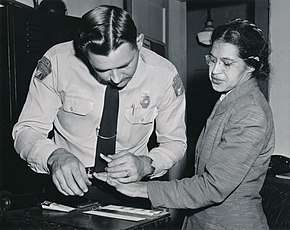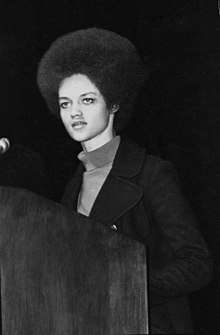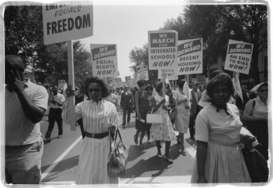African-American women in the civil rights movement
While White women during this period of time were looking for more areas of work outside the home, Black women during the civil rights movement often desired the opposite. African American women were from the beginning pushed into the American workforce, working outside the home and away from their families. African American women often desired the opportunity to work more domestic jobs in both their homes and near them, because with both mother and father working hard in the workforce, it was difficult for families to interact or engage in activities similar to the leisurely comforts that White families experienced. Because Black women were forced into these opportunities, “the Black woman has not, in general, had the luxury of viewing herself as oppressed from the standpoint of being female.”[1] Because of this, the accomplishments of these women should be appreciated through both a feminist, and anti-racism point of view.
_-_NARA_-_542013.tif.jpg)
Lack of exposure for African American women
Black women in the 1960s not only organized and led protests for civil rights, but expanded their reach into issues such as poverty, feminism, and other social matters. The "master narrative" would depict a civil rights movement constructed around notable male figures, which neglects to properly recognize female contributors. While women are not typically recognized for their efforts during this time, they were primary characters in executing a powerful and successful movement.

Many refer to Rosa Parks as an important part of Civil Rights history, but she is one of the only Black women to be celebrated and given credit for her actions. There are many hidden or unnamed women of the civil rights movement with roles which most curriculums and early education classes do not teach. Women like Coretta Scott King are often skipped over in lessons about the civil rights movement when they are in fact some of the most essential. This is detrimental to the overall education of children on the civil rights movement, as they are taught that men made all the change.
It has been suggested that because of gender ideals, women were more often than not, channeled away from formal leadership positions within the American civil rights movement, leaving them to tend to informal leadership positions, when available.[2] This may explain why standard narratives neglect to acknowledge the imperative roles of women in the civil rights movement, and remarkable then, that we have documentation of so many leadership positions that women did act in.
Womanism is the idea of supporting all women no matter their race or class, not simply focusing on females. As Black women have continually made sacrifices, “Womanism’s focus on the community has meant that, when challenged, Black women have historically put aside any differences that they have had for the greater good”.[1] This surrender of time, effort, and proper appreciation from their work is a clear and ongoing sacrifice by African American women
Roles of women in the movement
Supporting roles

Women in the Civil rights movement provided their time and skills on the front lines and behind the scenes. Some women provided their services by using their restaurants to prepare food for protestors, while others provided housing.[3] Many women opened their stores or homes to create safe-havens where civil rights workers could meet and discuss plans or strategies, some used their careers to raise funds for the cause. Women involved in the civil rights movement included students, mothers, and professors, as they balanced many roles in different parts of their lives.[4] Women such as Ida B. Wells used their journalism skills to provide protection for black women suffering from sexual violence.[3] It was not uncommon to find women arranging plans to put together the signs which would be held at marches, and leading chants or songs during these influential protests.
Leadership roles
Women not only provided help to those in leadership, but also held important positions in the leadership of the movement. This was a movement of women supporting women, within African Americans fighting for their rights. Student, Judy Richardson, left college to organize projects such as voter-registration drives.[3] Kathleen Cleaver took the risk of being the first woman to serve on the central committee of the Black Panther Party, making her a target of the FBI. Ella Mae Brayboy became the co-director of the voter registration drives sponsored by the Voter Education Project (VEP).[5] Grace Hamilton was the first African American woman to be elected to the state legislature in the south. Even more women ran for political offices during this period of time, but were overshadowed by the election of the first Black mayor, Maynard Jackson.[5] These leaders took positions of responsibility in which they accomplished great feats, most commonly left out of the narrative.
Notable African-American women in the movement
Ella Baker (1903 - 1986)

Ella Baker noted, “I don’t think you could go through the Freedom Movement without finding that the backbone of the support of the Movement were women. When demonstrations took place and when the community acted, usually it was some woman who came to the fore".[6]
Daisy Bates (1914 - 1999)
Although Daisy Bates and Ella Baker both held key positions in established civil rights organizations, each received little recognition as the "movement leaders" within the Black community, and both paid an economic price for their leadership roles. Bates, head of Little Rock's NAACP, lost the newspaper owned by her and her husband. Because of sexism within the movement, Baker was never given a permanent position in SCLC or a salary comparable to the man who replaced her.[2]
Septima Poinsette Clark (1898 - 1987)
Many respondents recalled Septima Clark with fondness, with respect, and with praise for her role as a teacher and organizer of adult "citizenship schools" throughout the South. One prominent male respondent, who himself was a "trainer" of civil rights field workers in the South, commented: Ah! What a human being.... There simply was no one like Septima Clark. Martin [King] knew and we all knew how courageous and how gifted this lady was.... She could talk on several intellectual levels.... As brilliant as she was, she could always get down on your level to make you understand and to make you comfortable.... Her role was essential... she taught citizen".[7]
References
- Duran, Jane (2015). "Women of the Civil Rights Movement". Philosophia Africana. 17 (2): 65–73. doi:10.5840/philafricana2015/20161727. ISSN 1539-8250.
- Robnett, Belinda (May 1996). "African-American Women in the Civil Rights Movement, 1954-1965: Gender, Leadership, and Micromobilization". American Journal of Sociology. 101 (6): 1661–1693. doi:10.1086/230870. ISSN 0002-9602.
- Bell, Janet Dewart (2018-04-25). "The Selfless Servant Leadership of the African-American Women of the Civil-Rights Movement". ISSN 0027-8378. Retrieved 2020-04-19.
- Hribar (2013). "Radical Women in the Struggle: A Review of Recent Literature on the Civil Rights and Black Freedom Movements". Journal of Feminist Studies in Religion. 29 (2): 95–115. doi:10.2979/jfemistudreli.29.2.95. JSTOR 10.2979/jfemistudreli.29.2.95.
- Nasstrom, Kathryn L. (April 1999). "Down to Now: Memory, Narrative, and Women's Leadership in the Civil Rights Movement in Atlanta, Georgia". Gender & History. 11 (1): 113–144. doi:10.1111/1468-0424.00131. ISSN 0953-5233.
- Vickery, Amanda; Trent, Kyra; Salinas, Cinthia (2019-10-02). ""The Future Is Intersectional": Using the Arts to Reinsert Black Women Into the Civil Rights Narrative". Multicultural Perspectives. 21 (4): 224–232. doi:10.1080/15210960.2019.1686384. ISSN 1521-0960.
- Barnett, Bernice McNair (1993). "Invisible Southern Black Women Leaders in the Civil Rights Movement: The Triple Constraints of Gender, Race, and Class". Gender and Society. 7 (2): 162–182. doi:10.1177/089124393007002002. ISSN 0891-2432. JSTOR 189576.